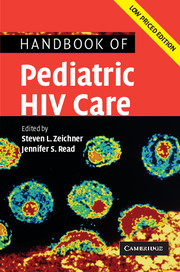Book contents
- Frontmatter
- Contents
- List of contributors
- List of abbreviations
- Foreword
- Preface
- Part I Scientific basis of pediatric HIV care
- Part II General issues in the care of pediatric HIV patients
- Part III Antiretroviral therapy
- Part IV Clinical manifestations of HIV infection in children
- 18 Cutaneous diseases
- 19 Neurologic problems
- 20 Ophthalmic problems
- 21 Oral health and dental problems
- 22 Otitis media and sinusitis
- 23 Cardiac problems
- 24 Pulmonary problems
- 25 Hematologic problems
- 26 Gastrointestinal disorders
- 27 Renal disease
- 28 Endocrine disorders
- 29 Neoplastic disease in pediatric HIV infection
- Part V Infectious problems in pediatric HIV disease
- Part VI Medical, social, and legal issues
- Appendix 1 Formulary of antiretroviral agents
- Appendix 2 National Institutes of Health sponsored clinical trials for pediatric HIV disease
- Appendix 3 Selected HIV-related internet resources
- Appendix 4 Selected legal resources for HIV-infected children
- Index
- References
21 - Oral health and dental problems
Published online by Cambridge University Press: 23 December 2009
- Frontmatter
- Contents
- List of contributors
- List of abbreviations
- Foreword
- Preface
- Part I Scientific basis of pediatric HIV care
- Part II General issues in the care of pediatric HIV patients
- Part III Antiretroviral therapy
- Part IV Clinical manifestations of HIV infection in children
- 18 Cutaneous diseases
- 19 Neurologic problems
- 20 Ophthalmic problems
- 21 Oral health and dental problems
- 22 Otitis media and sinusitis
- 23 Cardiac problems
- 24 Pulmonary problems
- 25 Hematologic problems
- 26 Gastrointestinal disorders
- 27 Renal disease
- 28 Endocrine disorders
- 29 Neoplastic disease in pediatric HIV infection
- Part V Infectious problems in pediatric HIV disease
- Part VI Medical, social, and legal issues
- Appendix 1 Formulary of antiretroviral agents
- Appendix 2 National Institutes of Health sponsored clinical trials for pediatric HIV disease
- Appendix 3 Selected HIV-related internet resources
- Appendix 4 Selected legal resources for HIV-infected children
- Index
- References
Summary
Many children with HIV have oral manifestations of the infection (Table 21.1), including some that are part of the 1994 CDC classification system [1]. Since the introduction of antiretroviral therapy and highly active antiretroviral therapy (ART and HAART), the prevalence of these oral manifestations has decreased. However, in many countries where therapy is less than ideal, such as Romania, Brazil, and Mexico, HIV-associated oral lesions are more common, with prevolenic ranging from 55%–61% [2–4]. Their presence can still be used as markers for progression of disease. Referral to a dentist before 1 year of age is recommended for all children, but this is especially important for the HIV-infected child. Careful examination of the soft tissues and teeth is essential.
Oral mucosal lesions
Fungal infections
Oral candidiasis (thrush) is by far the most common oral opportunistic infection in HIV-infected children [5–8]. Prevalence estimates in this group range from 28%–67% (Table 21.1), and its presence is associated with low or declining CD4 counts [7, 8]. The diagnosis and treatment of Candida infections are discussed in detail in Chapter 33.
Oral candidal infections can appear as a red patch (erythematous, Fig. 21.1), a white patch that rubs off (pseudomembranous) or as red patches at the corners of the mouth (angular chelitis). Often, patients are asymptomatic, but they may experience oral burning or soreness. The diagnosis of oral candidiasis is based on clinical appearance and the presence of hyphae on a smear prepared with potassium hydroxide.
- Type
- Chapter
- Information
- Handbook of Pediatric HIV Care , pp. 535 - 542Publisher: Cambridge University PressPrint publication year: 2006



